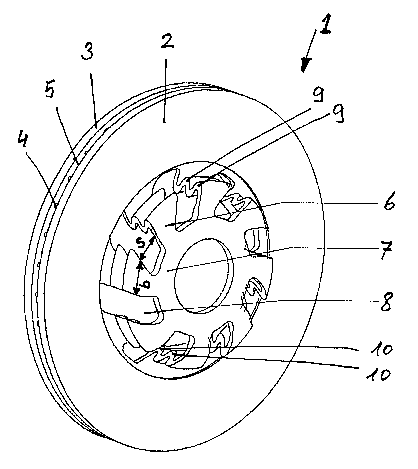Some of the information on this Web page has been provided by external sources. The Government of Canada is not responsible for the accuracy, reliability or currency of the information supplied by external sources. Users wishing to rely upon this information should consult directly with the source of the information. Content provided by external sources is not subject to official languages, privacy and accessibility requirements.
Any discrepancies in the text and image of the Claims and Abstract are due to differing posting times. Text of the Claims and Abstract are posted:
| (12) Patent Application: | (11) CA 2569801 |
|---|---|
| (54) English Title: | BRAKE DISC ASSEMBLY FOR VEHICLE WHEELS |
| (54) French Title: | SYSTEME DE FREIN A DISQUE POUR ROUES DE VEHICULE |
| Status: | Deemed Abandoned and Beyond the Period of Reinstatement - Pending Response to Notice of Disregarded Communication |
| (51) International Patent Classification (IPC): |
|
|---|---|
| (72) Inventors : |
|
| (73) Owners : |
|
| (71) Applicants : |
|
| (74) Agent: | ROBIC AGENCE PI S.E.C./ROBIC IP AGENCY LP |
| (74) Associate agent: | |
| (45) Issued: | |
| (86) PCT Filing Date: | 2005-08-30 |
| (87) Open to Public Inspection: | 2006-03-23 |
| Examination requested: | 2010-07-09 |
| Availability of licence: | N/A |
| Dedicated to the Public: | N/A |
| (25) Language of filing: | English |
| Patent Cooperation Treaty (PCT): | Yes |
|---|---|
| (86) PCT Filing Number: | PCT/EP2005/009311 |
| (87) International Publication Number: | WO 2006029705 |
| (85) National Entry: | 2006-12-04 |
| (30) Application Priority Data: | ||||||
|---|---|---|---|---|---|---|
|
The invention relates to a brake disc assembly (1) for vehicle wheels,
comprising at least one friction ring (2, 3) and a wheel fixing zone (7) that
runs parallel to the friction ring (2, 3). Said friction ring (2, 3) and wheel
fixing zone (7) are configured in one-piece from a die-cast material and
connecting struts (6) are formed between the friction ring (2, 3) and the
wheel fixing zone. Said assembly is characterised in that the connecting
struts (6) are elastically sprung in a radial and axial direction.
La présente invention concerne un système de frein à disque (1) destiné à des roues de véhicule, comprenant au moins un anneau de frottement (2,3) et une zone de fixation à la roue (7) qui s'étend parallèlement à l'anneau de frottement (2,3). Selon l'invention, l'anneau de frottement (2,3) et la zone de fixation à la roue (7) sont réalisés en une seule pièce dans un matériau coulé, et des brides de liaison (6) sont formées entre l'anneau de frottement (2,3) et la zone de fixation à la roue. L'invention se caractérise en ce que les brides de liaison (6) sont réalisées pour exercer une force de rappel élastique en direction radiale et en direction axiale.
Note: Claims are shown in the official language in which they were submitted.
Note: Descriptions are shown in the official language in which they were submitted.

2024-08-01:As part of the Next Generation Patents (NGP) transition, the Canadian Patents Database (CPD) now contains a more detailed Event History, which replicates the Event Log of our new back-office solution.
Please note that "Inactive:" events refers to events no longer in use in our new back-office solution.
For a clearer understanding of the status of the application/patent presented on this page, the site Disclaimer , as well as the definitions for Patent , Event History , Maintenance Fee and Payment History should be consulted.
| Description | Date |
|---|---|
| Time Limit for Reversal Expired | 2012-08-30 |
| Application Not Reinstated by Deadline | 2012-08-30 |
| Deemed Abandoned - Failure to Respond to Maintenance Fee Notice | 2011-08-30 |
| Inactive: Office letter | 2011-01-14 |
| Letter Sent | 2011-01-14 |
| Inactive: Delete abandonment | 2011-01-14 |
| Inactive: Correspondence - Prosecution | 2010-12-30 |
| Inactive: Abandon-RFE+Late fee unpaid-Correspondence sent | 2010-08-30 |
| Inactive: Correspondence - MF | 2010-08-10 |
| Request for Examination Requirements Determined Compliant | 2010-07-09 |
| Request for Examination Received | 2010-07-09 |
| All Requirements for Examination Determined Compliant | 2010-07-09 |
| Letter Sent | 2007-11-08 |
| Inactive: Single transfer | 2007-09-21 |
| Inactive: Cover page published | 2007-02-06 |
| Inactive: Courtesy letter - Evidence | 2007-02-06 |
| Inactive: Notice - National entry - No RFE | 2007-01-31 |
| Application Received - PCT | 2007-01-10 |
| National Entry Requirements Determined Compliant | 2006-12-04 |
| Application Published (Open to Public Inspection) | 2006-03-23 |
| Abandonment Date | Reason | Reinstatement Date |
|---|---|---|
| 2011-08-30 |
The last payment was received on 2010-07-23
Note : If the full payment has not been received on or before the date indicated, a further fee may be required which may be one of the following
Please refer to the CIPO Patent Fees web page to see all current fee amounts.
| Fee Type | Anniversary Year | Due Date | Paid Date |
|---|---|---|---|
| Basic national fee - standard | 2006-12-04 | ||
| MF (application, 2nd anniv.) - standard | 02 | 2007-08-30 | 2007-07-25 |
| Registration of a document | 2007-09-21 | ||
| MF (application, 3rd anniv.) - standard | 03 | 2008-09-02 | 2008-07-24 |
| MF (application, 4th anniv.) - standard | 04 | 2009-08-31 | 2009-07-27 |
| Request for examination - standard | 2010-07-09 | ||
| MF (application, 5th anniv.) - standard | 05 | 2010-08-30 | 2010-07-23 |
Note: Records showing the ownership history in alphabetical order.
| Current Owners on Record |
|---|
| GEORG FISCHER FAHRZEUGTECHNIK AG |
| Past Owners on Record |
|---|
| ANDREAS HECKER |
| GUIDO RAU |
| TORSTEN RIECK |